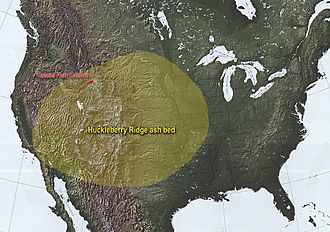Huckleberry Ridge Tuff facts for kids
Quick facts for kids Huckleberry Ridge eruption |
|
|---|---|

Huckleberry Ridge ash bed
|
|
| Volcano | Island Park Caldera |
| Date | 2.1 million years ago |
| Type | Ultra-Plinian |
| Location | Idaho/Wyoming, United States 44°20′N 111°20′W / 44.33°N 111.33°W |
| VEI | 8 |
The Huckleberry Ridge Tuff is a special type of rock. It was formed from a giant volcanic eruption. This eruption happened about 2.1 million years ago. It created a huge bowl-shaped area called the Island Park Caldera. This caldera is partly in Yellowstone National Park in Wyoming. It also stretches west into Idaho, near a place called Island Park.
This ancient eruption was incredibly powerful. Scientists believe it was the biggest eruption ever from the Yellowstone hotspot. It released a massive amount of material, about 2,200 cubic kilometers. To give you an idea, that's enough material to cover a large city many times over! This event was the third most recent huge eruption that formed a caldera from the Yellowstone hotspot. Later, two other big eruptions happened: the Mesa Falls Tuff and the Lava Creek Tuff eruptions.
Contents
What is the Huckleberry Ridge Tuff?
The Huckleberry Ridge Tuff is a type of rock. It forms when ash and other volcanic bits from an eruption settle down. These materials then get squished and cemented together over time. Imagine a huge cloud of ash and rock flying out of a volcano. When it lands, it cools and hardens into this unique rock.
How Tuff Rocks Are Formed
When a volcano erupts with great force, it shoots out a mix of hot gas, ash, and small rock pieces. This mixture is called pyroclastic flow. It can travel very fast across the land. As it settles, the hot material compacts. Over millions of years, it turns into a solid rock layer. This is how the Huckleberry Ridge Tuff was made.
The Giant Yellowstone Eruption
The Huckleberry Ridge eruption was one of the largest known volcanic events on Earth. It was so powerful that it caused the ground to collapse. This collapse formed the huge depression known as a caldera. The eruption is classified as an "Ultra-Plinian" event. This means it was an extremely explosive eruption. It sent ash high into the atmosphere.
Understanding Calderas
A caldera is a large, bowl-shaped hollow. It forms when a volcano's magma chamber empties during an eruption. The ground above the chamber then sinks inward. The Island Park Caldera is one such example. It was created by the Huckleberry Ridge eruption.
Yellowstone's Volcanic History
The Yellowstone area is famous for its hot springs and geysers. These are signs of a supervolcano beneath the surface. The Yellowstone hotspot has had several massive eruptions over millions of years. The Huckleberry Ridge eruption was the first of these three major caldera-forming events. It shows how active and powerful this area has been in the past.
Where is the Huckleberry Ridge Tuff Found?
You can find the Huckleberry Ridge Tuff in parts of Idaho and Wyoming. It's a key geological feature in the region. It helps scientists understand the history of the Yellowstone hotspot. The tuff layers are like pages in a book. They tell the story of ancient volcanic activity.
Exploring the Location
The tuff is spread across a wide area. It covers parts of the Island Park region in Idaho. It also extends into Yellowstone National Park in Wyoming. Geologists study these rock formations. They learn about the size and power of past eruptions.
See also
 In Spanish: Toba de Huckleberry Ridge para niños
In Spanish: Toba de Huckleberry Ridge para niños

